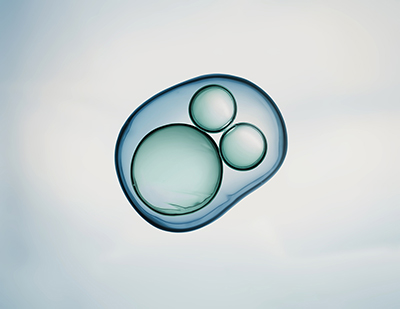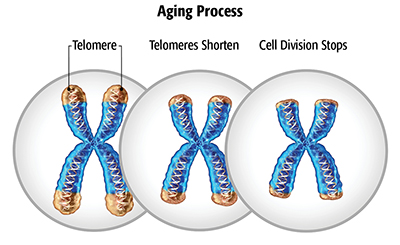Any Truth to the Fountain of Youth?
Does the fountain of youth exist? The concept of human physical immortality, free of aging, has enticed humanity for centuries. Today, this question remains elusive. What we can say for sure is that science has discovered a way to reverse aging based on a Nobel prize–winning discovery by Japanese stem-cell scientist Shinya Yamanaka. He discovered a group of protein transcription factors that play a vital role in the creation of induced pluripotent stem cells (cells that have the ability to become any cell in the body) by wiping clean the epigenetic marks in a cell, giving it a fresh start. Collectively, these proteins are known as the Yamanaka factors (Oct3/4, Sox2, Klf4, c‑Myc) or are sometimes referred to as OSKM genes. Yamanaka demonstrated how adding just four proteins to human adult cells could reprogram them so that they look and act like those in a newly formed embryo.[1]
 Even though this is an enticing idea to reverse aging at the stem-cell level, some may want a less invasive method. One of the most potent molecules involved in antiaging processes is nicotinamide adenine dinucleotide (NAD+). It plays an essential role in cell functions such as energy metabolism, stress response, and gene expression. Perhaps the most important role of NAD+ is its ability to repair DNA, which is our blueprint for gene expression. Before you start googling where to buy it, it is important to note that NAD+ is a molecule that cannot be absorbed in the GI tract. NAD+ is not a vitamin in itself, but it is derived from vitamin B₃ (niacin) and other precursors like tryptophan, nicotinamide riboside (NR), and nicotinamide mononucleotide (NMN).
Even though this is an enticing idea to reverse aging at the stem-cell level, some may want a less invasive method. One of the most potent molecules involved in antiaging processes is nicotinamide adenine dinucleotide (NAD+). It plays an essential role in cell functions such as energy metabolism, stress response, and gene expression. Perhaps the most important role of NAD+ is its ability to repair DNA, which is our blueprint for gene expression. Before you start googling where to buy it, it is important to note that NAD+ is a molecule that cannot be absorbed in the GI tract. NAD+ is not a vitamin in itself, but it is derived from vitamin B₃ (niacin) and other precursors like tryptophan, nicotinamide riboside (NR), and nicotinamide mononucleotide (NMN).
Nicotinamide adenine dinucleotide levels naturally decline with age, and by age 40, this decrease becomes particularly pronounced in the skin. This significant drop in NAD+ is a key factor in the accelerated aging of the skin after 40. In fact, NAD+ levels drop by 50% every 20 years.[2] In your body, NAD+ is converted to NADH, which is then used to drive the production of adenosine triphosphate (ATP) in the mitochondria. ATP is the most usable form of energy for your cells. NAD+ is continuously synthesized, consumed, and recycled within the cell to maintain stable levels.
NAD+ is crucial for activating sirtuins, which are proteins that play a role in regulating cellular processes such as DNA repair and metabolism. Sirtuins, in turn, help drive mitochondrial ATP production within the cell. Without sufficient ATP energy from the mitochondria, cells become weakened and are less capable of repairing themselves, which can lead to chronic inflammation, autoimmune reactions, and tissue damage.
As mentioned previously, since NAD+ is a molecule that cannot be absorbed in the GI tract, if you do choose to take an NAD+ supplement, you are most likely taking one of its most direct precursors, nicotinamide mononucleotide (NMN) or nicotinamide riboside (NR).
 Even though NMN is a smaller molecule than NAD+, some scientists considered it too large to be fully absorbed. However, recent genomic data show that humans have a gene, called SLC12A8, similar to one in rodents, that might help transport NMN into cells, especially in the gut. This gene is highly active in the small intestine, stomach, testis, thyroid, and colon, allowing NMN to enter the bloodstream and be distributed to various tissues for use and transformation into NAD+.[3]
Even though NMN is a smaller molecule than NAD+, some scientists considered it too large to be fully absorbed. However, recent genomic data show that humans have a gene, called SLC12A8, similar to one in rodents, that might help transport NMN into cells, especially in the gut. This gene is highly active in the small intestine, stomach, testis, thyroid, and colon, allowing NMN to enter the bloodstream and be distributed to various tissues for use and transformation into NAD+.[3]
Nicotinamide riboside, another precursor to NAD+, is also absorbed in the gastrointestinal (GI) tract. Once inside cells, NR is first converted to NMN. NMN is the final step before being converted to NAD+. Researchers found that NR significantly boosts NAD+ levels in yeast. Subsequent research has demonstrated that NR can increase NAD+ levels in mammalian cells by as much as 270%.[4]
There is a significant link between telomere length and cell damage. When there is an abundance of NAD+, sirtuins, the antiaging proteins, are activated, promoting cellular resilience and DNA repair.[5] Sirtuins are proteins implicated in the aging process by their ability to minimize telomere attrition (shortening). Telomeres are the protective endcaps on chromosomes, much like the aglets on the ends of shoelaces that keep them from fraying. With each cell division, these telomeres shorten until they are eventually depleted, which can lead to cellular aging and cellular damage. When telomeres become critically short, cells enter a state of senescence where they can no longer repair themselves, leading to increased chromosome instability and accelerated aging. This process is associated with age-related diseases such as cancer and weakened immune function. Research shows that biological aging is a more accurate predictor of mortality than an individual’s chronological age (age based on date of birth).[6]
What Factors Lead to Accelerated Telomere Shortening?
Factors such as stress,[7] smoking, excess weight, poor lifestyle, immobility, and overconsumption of food are some of the factors that may lead to telomere attrition.[8], [9]
What Can You Do to Help Preserve Your Telomeres?
Stress-reduction techniques—such as meditation and getting good sleep—can increase telomere stability.[10], [11] Another popular method to enhance telomere length is fasting. Intermittent or prolonged fasting was shown to activate sirtuins.[12] Fasting also triggers processes that boost NAD+ levels, which play a role in metabolic pathways including fat burning. When you are not fasting, your body uses glucose for energy, which can lower NAD+ levels. To maintain consistent NAD+ levels and support fat burning after fasting, it is beneficial to take NAD+ supplements.[13]
Supplements such a resveratrol are important in preserving telomere integrity and genomic stability.[14] NMN and NR, while effective in boosting NAD+ levels, can degrade into niacin (vitamin B₃), especially in unstable forms. Although NAD+ supplements are available over the counter, high doses of an unstable form can pose risks similar to those of niacin, such as serious muscle pain or liver damage. In the realm of NAD+ supplementation, the microcrystalline forms of NMN and NR chloride are recognized as stable and effective options for maintaining optimal NAD+ levels.
In conclusion, NAD+ is a crucial substance that mitochondria use to create ATP, the energy source that every cell in your body needs continuously. Supplementing with NR or NMN is an effective way to boost your NAD+ levels. While the Yamanaka factors, or OSKM, have shown promise to reverse aging, they still require more research before broad application to the general population. For now, the clinical evidence indicates that NR, NMN, and resveratrol may provide safer and effective options for stabilizing chromosomes and slowing down telomere attrition to potentially counteract the aging process that promote production of NAD+.
 Dr. Ky Lo, BA, BSc, ND, LAc
Dr. Ky Lo, BA, BSc, ND, LAc
Dr. Lo is a naturopathic doctor who graduated from the Canadian College of Naturopathic Medicine (CCNM) in 2006. With over 20 years in the medical esthetics industry, she combines her knowledge with naturopathic training to offer a unique perspective on antiaging.
[1] Liu, X., J. Huang, T. Chen, Y. Wang, S. Xin, J. Li, G. Pei, and J. Kang. “Yamanaka factors critically regulate the developmental signaling network in mouse embryonic stem cells.” Cell Research, Vol. 18 (2008): 1177–1189.
[2] [No authors listed.] “What age do NAD+ levels decline?” Science for Optimal Living and Rejuvenation, 2020‑01‑25, https://www.solrglobal.com/insights-solr/what-age-do-nad-levels-decline.
[3] Grozio, A., K.F. Mills, J. Yoshino, S. Bruzzone, G. Sociali, K. Tokizane, H.C. Lei, et al. “Slc12a8 is a nicotinamide mononucleotide transporter.” Nature Metabolism, Vol. 1, No. 1 (2019): 47–57.
[4] Yang, T., N.Y. Chan, and A.A. Sauve. “Syntheses of nicotinamide riboside and derivatives: Effective agents for increasing nicotinamide adenine dinucleotide concentrations in mammalian cells.” Journal of Medicinal Chemistry, Vol. 50, No. 26 (2007): 6458–6461.
[5] Michishita, E., R.A. McCord, E. Berber, M. Kioi, H. Padilla‑Nash, M. Damian, P. Cheung, et al. “SIRT6 is a histone H3 lysine 9 deacetylase that modulates telomeric chromatin.” Nature, Vol. 452, No. 7186 (2008): 492–496.
[6] Goglin, S.E., R. Farzaneh‑Far, E.S. Epel, J. Lin, E.H. Blackburn, and M.A. Whooley. “Change in leukocyte telomere length predicts mortality in patients with stable coronary heart disease from the Heart and Soul Study.” PLoS One, Vol. 11, No. 10 (2016): e0160748. Erratum in: Goglin, S., R. Farzaneh‑Far, E.S. Epel, J. Lin, E.H. Blackburn, and M.A. Whooley. “Correction: Change in leukocyte telomere length predicts mortality in patients with stable coronary heart disease from the Heart and Soul Study.” PLoS One, Vol. 11, No. 12 (2016): e0168868.
[7] Law, E., A. Girgis, S. Lambert, J. Levesque, and H. Pickett. “Telomeres and stress: Promising avenues for research in psycho-oncology.” Asia-Pacific Journal of Oncology Nursing, Vol. 3, No. 2 (2016): 137–147.
[8] Shay, J. “Role of telomeres and telomerase in aging and cancer.” Seminars in Cancer Biology, Vol. 21, No. 6 (2011): 349–353.
[9] Blasco, M.A. “Telomere length, stem cells and aging.” Nature Chemical Biology, Vol. 3, No. 10 (2007): 640–649.
[10] Rathore, M., and J. Abraham. “Implication of asana, pranayama and meditation on telomere stability.” International Journal of Yoga, Vol. 11, No. 3 (2018): 186–193.
[11] [No authors listed.] “Sirtuins: Linking the circadian clock to your metabolism.” Science for Optimal Living and Rejuvenation, 2020‑01‑04, https://www.solrglobal.com/insights-solr/sirtuins-linking-the-circadian-clock-to-your-metabolism.
[12] Zhu, Y., Y. Yan, D.R. Gius, and A. Vassilopoulos. “Metabolic regulation of sirtuins upon fasting and the implication for cancer.” Current Opinion in Oncology, Vol. 25, No. 6 (2013): 630–636.
[13] [No authors listed.] “NAD+ supplements and fasting.” Science for Optimal Living and Rejuvenation, 2020‑01‑11, https://www.solrglobal.com/insights-solr/nad-supplements-and-fasting.
[14] Gutlapalli, S.D., V. Kondapaneni, I.A. Toulassi, S. Poudel, M. Zeb, J. Choudhari, and I. Cancarevic. “The effects of resveratrol on telomeres and post myocardial infarction remodeling.” Cureus, Vol. 12, No. 11 (2020): e11482.

 Stores
Stores